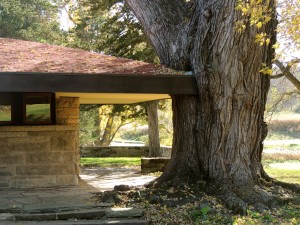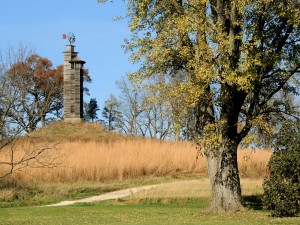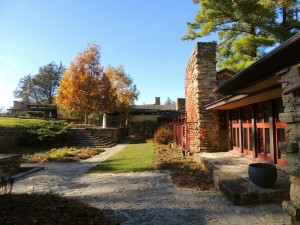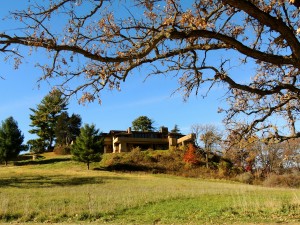The Renaissance of Wright
It’s nearly impossible to find just one word to describe Frank Lloyd Wright’s work. The closest comparison seems to be a snowflake crossed with a favorite color: unique, intricate and mesmerizing, yet comforting and resonant. Wright’s enduring genius puts him in the ranks of Picasso, Gershwin, Fitzgerald and Disney.
But unlike most artistic masterpieces, Wright’s creations are not just to be looked at, but lived in, moved through and experienced.
“Everything he did was a social science experiment,” says Mark Nelson, a design and architecture professor at UW-Madison, Wright’s own alma mater.
“That’s why his buildings fall down, because he was trying stuff that nobody had ever done … He was making people behave in different ways than they normally did. I go into some of his stuff, and I have to duck. He knew that. Or sometimes the corridors are only two feet wide… it forces you to do things differently. He wanted people to interact in certain ways, and he built them into his buildings.”
Wisconsin residents, especially those in Madison and Milwaukee, don’t have to go far to see firsthand what Nelson is describing. Wright, who in 1991 was voted the greatest American architect of all time by the American Institute of Architects, is a Wisconsin native. And while much of his work is scattered across the country and world, many of his buildings are right here in Wisconsin, including his own home, Taliesin.

The estate’s theater merges with a tree, exemplifying Wright’s organic style of architecture. Photo by Katherine Fadelli.
And soon, Taliesin — on 600 acres of rolling hills and forest along the Wisconsin River, an hour west of Madison near Spring Green, Wisconsin — may be considered more hallowed than Big Ben or the Eiffel Tower. This renewed recognition is breathing new life into Wright’s work and offering insight into a mind that imagined an architecture that connected more than wood and stone, but man and nature.
All the Wright Things
Stonehenge, the Great Wall of China, the Colosseum and the Pyramids of Giza are all considered by the UN Education, Scientific and Cultural Organization, or UNESCO, to be of “outstanding universal value.” These are a few of the 1,031 destinations across the globe that have been ordained by UNESCO, among national parks and other exceptionally breathtaking landscapes, as World Heritage Sites.
Not since Founding Father Thomas Jefferson built his celebrated Virginia home Monticello in 1772 has an American created something worthy of World Heritage status. But that may change next year.
The United States nominated 10 of Wright’s buildings to become World Heritage Sites. If accepted by the committee in 2016, Wright’s work will belong to one of the most exclusive clubs in the world.
Of the 23 World Heritage Sites in the U.S., only a quarter are buildings; the rest are national parks and remains from indigenous peoples. And of the five structures, only two are designed by American architects: Monticello and Liberty Hall in Philadelphia, designed by Alexander Hamilton and the site where both the Constitution and Declaration of Independence were signed.

This water pump, designed by Wright, is made of two structures known as Romeo and Juliette, each unable to stand without the embrace of the other. Photo by Katherine Fadelli.
If Taliesin and nine of Wright’s other buildings are awarded the status, Wisconsin will be home to two: Taliesin and Herbert and Katherine Jacobs House in Madison. The other Wright buildings up for recognition reside in Chicago, California, Oklahoma and Arizona, with the most famous being the Guggenheim Museum in New York City and Fallingwater in Pennsylvania, known for a waterfall running underneath the house.
“It was cutting edge for its time, and it still looks modern,” says Charles Guadagnino, a Wright enthusiast who restores Wright-designed homes in Milwaukee through the Wright in Wisconsin Foundation.
Guadagnino grew up in New York City, and while he was vaguely familiar with Wright due to the Guggenheim, it wasn’t until he found himself in La Crosse, Wisconsin, courting the woman who is now his wife, that he became interested in Wright.
“I started looking at these houses … and I actually very much disliked them,” Guadagnino says of the homes built by Wright’s peers during his active years. “I found the colors, most of which were darker and more earth tones, not like the so-called ‘pretty’ colors other houses had. I found them interesting and not that attractive at first. I thought it was odd that some of the window placements were different. A lot of them had no front door entries so it’s kind of a little adventure to get into the house.”
Guadagnino’s curiosity led him to research Wright. Soon enough, Guadagnino had an affinity for all things Wright.
“There was literally nothing else like it out there,” he says. His 22-year-old daughter, Anne, agrees.
“We went to Fallingwater when we were very little and I remember there was a really big spider in the fireplace. And someone on the tour stopped the tour, like, ‘Everyone get out!’ because it was huge. It was this poisonous black spider, and the tour guide was like, ‘Well, that’s Frank Lloyd Wright for you. He’s bringing nature to you,’” Anne says.
The Wright Price
Ken Dahlin, who attended UW-Milwaukee’s School of Architecture and Urban Planning, has loved Frank Lloyd Wright’s work since he was 14, but he found little encouragement in pursuing Wright’s “organic” style of architecture that incorporates nature and the environment into a design. It wasn’t until 1992 when he started his own firm, Genesis Architecture, that he was able to embrace the technique that Wright pioneered.
“Wright talked about this integrity that a work of architecture would have, a harmonious architecture where all the details, all the parts relate to this cohesive whole that’s kind of singing the same symphony,” Dahlin says.
Take a trip to Taliesin and this idea is illuminated. A corner of the theater’s roof literally merges with a tree trunk. Wright referred to the main studio on the property as the “abstract forest,” and trees weave seamlessly between stone from the main house. Jim Erickson, Taliesin’s estate manager, calls it “a quintessential pairing of man and nature.” (Notably, in the mid-1990s, a large oak tree that helped create the effect of interior space while outside crashed into the home. The preservation is now careful to not let nature get too unwieldy.)
Dahlin, who now teaches at UW-Milwaukee, is working toward a doctorate in architecture. He’s focusing on disassembling Wright’s design principles to make sense of Wright’s enigmatic, effortless and enduring work. So far, Dahlin’s theories have connected Wright to principles of early 19th-century philosophy and perceptual psychology.
But Dahlin may already be the most successful architect authentically replicating Wright’s style. He won Innovation in Housing awards in 1989 and 1993 before receiving Better Homes and Gardens’ Home of the Year award in 2001.
While Dahlin mainly serves southeastern Wisconsin from his Racine-based firm, his homes can be found in Spring Green, Door County, Chicago, Lake Geneva, and — satisfying an emerging demand outside of the Midwest — Florida and Arizona.
Do it Wright
“The idea was that you would train your mind,” Nelson says of what went on in Wright’s home, Taliesin. “Creativity wasn’t just about making buildings. It was about making a whole person.”
At Wright’s private estate, the public could pay to see films at Wright’s theater. But because Wright was such a renowned host, the theater was perhaps better known for entertaining his guests after his famous Sunday evening formal dinners. Each week his “fellowship” — architecture students who more accurately resembled disciples — would prepare and attend the black-tie dinner frequented by high-society types.

Wright didn’t believe in building on top of hills, thus Taliesin opens to the peak of the hill. Photo by Katherine Fadelli.
Though Wright believed architecture was the highest form of art, he had the utmost respect for all the arts and required those in his fellowship to practice art, music and dance, says Erickson. To this day, students at the Frank Lloyd Wright School of Architecture live at Taliesin and continue the formal Sunday evening events, acting in productions of their own in the theater.
But the arts aren’t the only thing that’s continued at Taliesin for nearly a century. Along with Wisconsin’s famed environmentalists John Muir and Aldo Leopold, Wright’s regard for nature was ahead of his time.
A fully functional barn and farm was paramount to Wright’s vision of life. Pigs, goats, chickens, sheep and even bees were housed at Taliesin to feed Wright, his family, his fellowship and his guests. Timber was harvested directly from the land and Wright eventually installed a water wheel to generate electricity.
“Taliesin is Frank Lloyd Wright’s biography in wood and stone,” says Erickson, whose duties as estate manager range from clearing trails and mowing lawns to restoring the many aspects of Taliesin to the state they were in when Wright passed away. Using photos from 1959, the foundation has removed walls, installed Wrightian fixtures and arranged furniture to replicate how Wright intended Taliesin to be.
The restoration work the preservation champions is funded by popular tours offered April through November, which range from $15 to $85. Yet tour revenues alone hardly cover the costs of keeping the estate staffed and in good condition. Taliesin’s caretakers have high hopes for making the estate a money maker through events like writing workshops and music festivals.
Preserving Wright’s legacy thus far has focused on his architecture, but with additional resources, Erickson foresees leveraging Wright’s influential ideas about the arts, culture and nature to move the preservation forward.
While Wright’s buildings and homes may need repair, his legacy may only get stronger with the march of time.
“He is very unique,” Nelson says. “Five hundred years from now, people will still be talking about him. Taliesin will probably still be there. It’ll be the only place in Wisconsin still there.”

